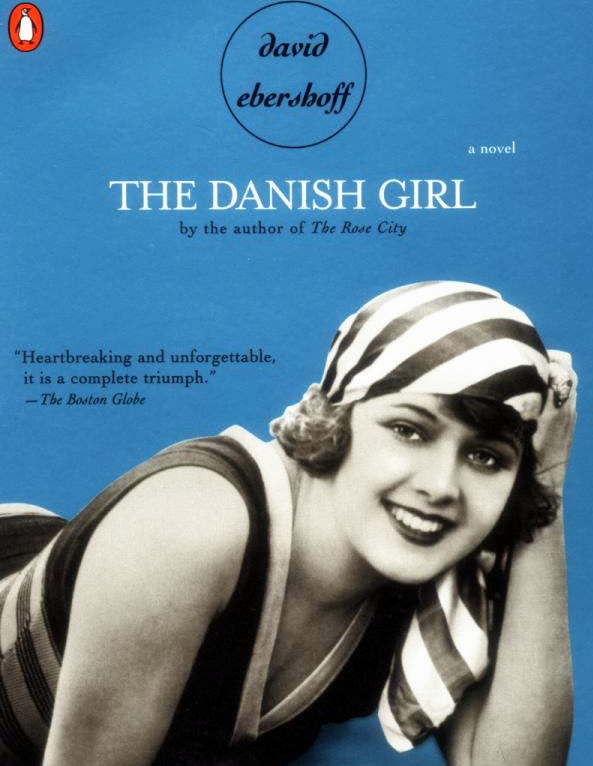 I caught up with David Ebershoff, author of The Danish Girl, about Lili Elbe, one of the first known recipients of gender reassignment surgery. This 2000 historical novel won a Lambda Literary Award and has been adapted into a film starring Eddie Redmayne and Alicia Vikander.
I caught up with David Ebershoff, author of The Danish Girl, about Lili Elbe, one of the first known recipients of gender reassignment surgery. This 2000 historical novel won a Lambda Literary Award and has been adapted into a film starring Eddie Redmayne and Alicia Vikander.
LISA ROSMAN: Let’s first establish your resume. In addition to being the author of The Danish Girl and other notable books, until recently you have been the vice president and executive editor at Random House. But now you’re just going to focus on writing.
DAVID EBERSHOFF: That’s right.
LR: Don’t you like the way I say just? Like that’s just all you’re going to do!
DE: [Laughs] Yes, for a long time I had two careers and I decided it was time to scale back to only one.
LR: I remember reading in Publisher’s Weekly a few years ago about how you couldn’t really imagine not having a day job. What was the shift there?
DE: Well, this was my twentieth year at Random House, and when I hit that milestone earlier this year, I started looking back at what I was so lucky to be a part of, and the writers I was fortunate to work with. When you start to look back, you also have to look forward, and I realized it felt like the right time to close that chapter on my life as an editor, and move into the next phase of my life as a writer.
LR: You’ve worked with an incredibly impressive roster of authors, including David Mitchell and Norman Mailer. How did working with these people impact your own writing?
DE: I think one of the most important things that any writer can do to grow him- or herself is to read and read widely into directions that you may not think that you’re interested in. This is how you figure out what works on the page, what other subjects you might be interested in, what kinds of stories you want to tell, and how you want to tell them. I did this for almost twenty years at Random House, where I edited as much nonfiction as fiction, and even poetry. When you’re an editor you learn to understand why a narrative is holding a reader’s attention and why it’s not. These are lessons I could take back to my writer’s desk.
LR: Did any of your authors affect your habits as writer?
DE: I always appreciate it when writers deliver their work in a professional way and go about their business and respect my role in it. The professionalism of being a writer is certainly something that I’ve tried to do myself.
 LR: So you’ve now written three historical novels – The Danish Girl, Pasadena, and The 19th Wife, which is technically a half-historical novel, since there’s a present-day story in it as well. Do you find that the form liberates you in some way? In The Danish Girl especially, I noticed that the prose was not entirely modern; there was a formal quality as well as a sensuousness that you don’t find too often today.
LR: So you’ve now written three historical novels – The Danish Girl, Pasadena, and The 19th Wife, which is technically a half-historical novel, since there’s a present-day story in it as well. Do you find that the form liberates you in some way? In The Danish Girl especially, I noticed that the prose was not entirely modern; there was a formal quality as well as a sensuousness that you don’t find too often today.
DE: For that book in particular, I tried to use prose to explore ideas of beauty, which fits thematically with what was going on in the characters’ lives. Both Lili Elbe and Gerda Wegener [Lili’s wife when she was Einar Wegener] were painters and their journeys are very much tied to their artwork. They were very interested in beauty and representing beauty, both on the canvas and in themselves. So I purposefully approached the book with this in mind and I tried to write it in a more painterly way.
LR: How did you choose the topic of Lili’s life?
DE: I first read about Lili Elbe almost eighteen years ago and was really struck by her story.
LR: People don’t always realize that she was among the first people to have gender reassignment surgery.
DE: Yes, I had always understood Christine Jorgensen to be the first. Christine was a GI from the Bronx who fought in World War II. She went to Copenhagen in 1951 as George Jorgensen and returned to America as Christine Jorgensen. But it turned out twenty years before there was Lili Elbe. She was not widely known except amongst certain academics and activists, and I was really interested in her because she was a pioneer who went through her journey with so few role models or examples for her to look to. And there was also the question of why history did not remember her.
LR: Do you have any theories about why that is?
DE: Some of it has to do with time and place. She concluded her transition in the early 1930s in Germany, not long before Hitler came to power. The next fourteen years in Germany and Europe were so devastating to so many millions of people that I believe her story was buried under this avalanche of horrible history. Another part is that her surgeries took place at the Dresden Municipal Women’s Clinic, which was completely destroyed in 1945 in the war. A lot of the records tying to the medical part of her story were lost. And of course another reason is the story itself – it’s the story of a transgender woman and until recently history was not embracing those.
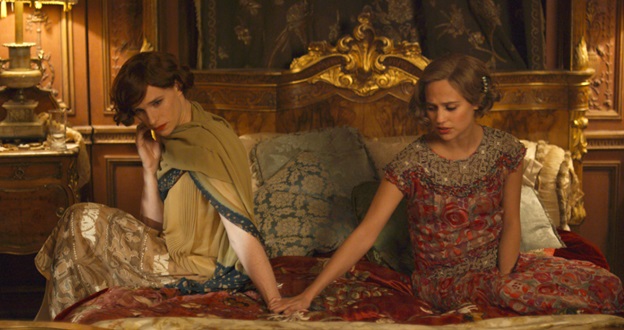 LR: Could it also have had to do with how Lili’s third round of surgeries was so unsuccessful?
LR: Could it also have had to do with how Lili’s third round of surgeries was so unsuccessful?
DE: I think that’s part of it. She didn’t live another twenty years and have a whole long life post-surgery, so some people might perceive that as being less triumphant. I see her as a hero. She knew what she was doing; she knew what she had to do to be herself.
LR: She was profoundly brave.
DE: She was so courageous and determined. Even at the end of her life, when she was struggling and ailing, she wrote letters that were full of enlightenment. She never doubted what she was doing or had done. I see her in the terms that she saw herself – that she truly became the woman she was meant to be. I hope that others will see her that way, too.
LR: Besides her writing, which is certainly fascinating and rich, what other research did you have to do?
DE: One of the most important things about this story are paintings that Gerda did of Lili when she was transitioning. They’re incredibly intimate and you sort of have to pull back and remember what they are. They are the paintings of a wife and the person she had thought was her husband. There is a very close sort of looking going on, and it’s a woman looking at another woman. In European and Western Art, we are so used to the male artist looking at the female, and these works completely turn the idea on its head. They show a type of honesty that is quite extraordinary. As a writer, I began to think about what kind of relationship could have led these two extraordinary women to paint and be painted in this way. That Lili would feel so comfortable to dress as herself and express herself in feminine terms in front of her wife, who in turn would feel so comfortable and interested in looking at Lili for hours. These paintings are very important for understanding anything about this relationship and the story of Lili Elbe.
LR: You talked in the afterword of this book about going to Europe and being in the space where they’d been.
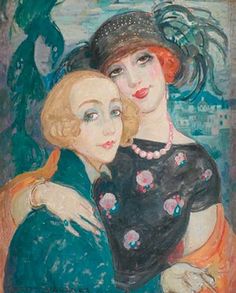 DE: I made several trips when I was writing the book. Although in Dresden nearly everything is gone, Copenhagen is a beautifully preserved city, and that’s really where their lives as artists and as a couple began. There is an art school called the Royal Academy of Art in central Copenhagen where they studied and fell in love. I went there in the late ’90s, and walked the same hallways where they walked, visited the same studios they painted in, paid attention to how the light fell through the windows at different times of the day. Then I returned to these buildings earlier this year because The Danish Girl was being filmed in the same spaces. It was remarkable for me to be where I had wandered around with my notebook eighteen years ago, now with the cast and crew of this beautiful film. To be shooting in the same space that Lili and Gerda actually were almost a hundred years ago was just really moving.
DE: I made several trips when I was writing the book. Although in Dresden nearly everything is gone, Copenhagen is a beautifully preserved city, and that’s really where their lives as artists and as a couple began. There is an art school called the Royal Academy of Art in central Copenhagen where they studied and fell in love. I went there in the late ’90s, and walked the same hallways where they walked, visited the same studios they painted in, paid attention to how the light fell through the windows at different times of the day. Then I returned to these buildings earlier this year because The Danish Girl was being filmed in the same spaces. It was remarkable for me to be where I had wandered around with my notebook eighteen years ago, now with the cast and crew of this beautiful film. To be shooting in the same space that Lili and Gerda actually were almost a hundred years ago was just really moving.
LR: How did you build the character of Lili in your novel?
DE: It is important to remember that Lili didn’t have any examples to study. There was nothing in the media for her to listen to or read, no role models, and almost no medical expertise for her to seek help from. She had to find her own way and was alone with the exception of Gerda. So sometimes she looked to less-than-complex representations of what a woman was and what a woman did and grabbed at those as a way to express her feminine self. That sometimes resulted in embracing the attention of men. If a man paid her attention she relished it, even if that might not be how every transgender woman goes through her transition. It’s important to say each transgender person will have their own sexual orientation – there is no rule to what a transgender person’s sexual orientation will be. Lili’s experience is her experience – but it may not be what a transgender woman would go through today. As we hear more and more stories about being transgender, each has its own unique story, each has its own milestones and no one story represents what it means to be transgender.
LR: On one hand, we have Lili, whose femininity could be described as very conventional but also very constructed. On the other hand, we have Gerda, who embodies the suffragette vibe of the era and this beautiful sort of female masculinity. This seems like one of the really interesting aspects of their relationships – versions of female liberation that were very different but also seemed complementary.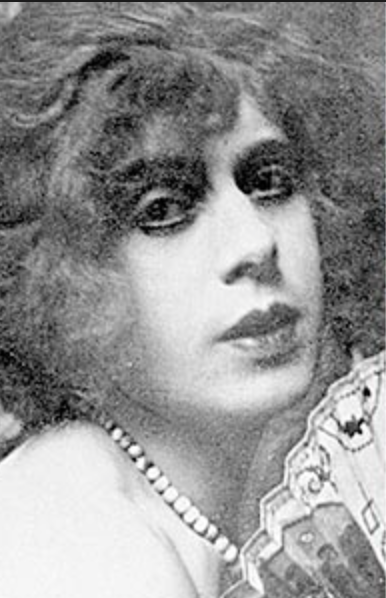
DE: I agree with you that Gerda is liberated; she defies expectations of what she should be and how she should act. You know, one of the things that doesn’t fully exist in the historical record is the intimacy of their relationship. The two were together so often that there was very little opportunity for them to write to each other, so there aren’t really many letters that describe their love story. So this is where I had to use conjecture and imagination to bring the reader into the intimate space of their marriage. I decided that I needed to invent the character of Gerda more than Lili and make her biographical background more fictional. However, I do believe that the emotional journey that Greta goes on in the book is accurate to the journey that Gerda went on in reality. [Ebershoff changed the Danish Gerda’s name to Greta and made her an American; both details were reverted in the film.] She embraced the emergence of Lili and then realized what it meant for their marriage, and had a complicated reaction to it. Yet she was still able to love her even when their marriage became something wholly unexpected.
LR: It’s a very inspiring love. Most relationships are based upon the initial contract of how you’re going to know each other but this one transcends that with such power and unconditional love.
DE: Thank you.
 LR: The idea of being an artist versus being art itself is everywhere in this story. Greta comes into her own as a painter by painting Lili into existence. But at the same time, as Lili comes into existence, Einar disappears and so does his painting, since Lili was not a painter.
LR: The idea of being an artist versus being art itself is everywhere in this story. Greta comes into her own as a painter by painting Lili into existence. But at the same time, as Lili comes into existence, Einar disappears and so does his painting, since Lili was not a painter.
DE: For the most part, she wasn’t, that’s true. There are a few examples of work that she did after living entirely as Lili but nothing like the successful productivity that she had when she was living as Einar. What was also interesting about that, as you say, is Greta became a very successful painter off these paintings of Lili, who is hyper-feminine in them. They’re very stylized paintings that are quite accurate to Lili’s spirit but not literal. They are the most beautiful versions of her and set an ideal that Lili could never live up to, because they were a kind of femininity that no woman could ever live up to. So that set the standard for what Lili was seeing herself as and perhaps informs why she relied on some tropes of the feminine in creating herself.
LR: Well, as you said, every transgender person’s experience of transformation is different. You captured a certain magic in the construction of Lili. She appears and disappears so suddenly, and doesn’t just have a different gender from Einar but also a different age. She even has periodic bleedings, although they are from her nose and anus instead.
DE: In her writing, Lili described these mysterious bleedings coming from both her nose and from her anus that followed a monthly cycle at one point. Some of her doctors left an indication that they discovered underdeveloped ovarian tissue in her abdomen, which might have caused some kind of internal bleeding, but there’s no final record on it and no final explanation. Lili may have elevated this detail of her story but I felt it was important to include it because she felt it was important. I do believe that at the end of Lili’s life, she self-mythologized, as many people do. The way she wrote about herself is not entirely true as we now know.
LR: Welcome to memoir!
DE: [Laughs] Exactly! I think of E. L. Doctorow, who said the boundaries between fiction and nonfiction simply don’t interest him because the way people talk about themselves is a complete blur between fiction and nonfiction. That’s not being cynical or skeptical. That’s just human nature.
LR: In reading about Lili, I realized there was actually a media frenzy around her that you choose to omit. Writing about the media seems to be a trap a lot of authors can’t help but fall into nowadays. It’s interesting that you sidestepped it.
DE: For this story I didn’t really want to go into the Meta. There are so many themes in the story of Lili Elbe that could go big really easily, all sorts of ideas of identity and gender, politics and culture. There’s nothing wrong with approaching it that way but I felt that what I could do as a writer was tell the story of what this experience did to Lili and Gerda individually and to their relationship. That was my lens.
LR: Let’s talk about your experience with the adaptation process.
DE: I feel really lucky that such great filmmakers got involved. It started with an amazing producer named Gail Mutrux, who optioned the book fifteen years ago and just never gave up. I always trusted that she would guide this story to the right version of itself, and she did. The wonderful screenwriter Lucinda Coxon wrote a really beautiful script, which convinced Tom Hooper to come on board as director. Then a lot fell into place very quickly. Eddie Redmayne came on as the lead. Working Title became the studio in the UK.
LR: Did you and Lucinda have a lot of discussions as she put together the screenplay?
DE: We had a few conversations but they were general. I trusted her as I trusted Gail. When an adaptation happens things are going to change and you can’t control that. I always felt that she was honoring Lili and the love story. There’s a tone and mood in the book that I feel is also present in the movie. I think it’s really astounding that they found a way of moving that from page to screen. As a writer, I felt my job was to take the reader inside these two characters and on the screen it’s a different thing that has to be accomplished. The audience has to believe that Eddie transitions to becoming a woman, and this was pulled off in an extraordinary way.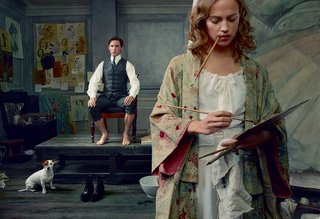
LR: Gerda and Einar’s relationship is more frankly and conventionally sexual in the film than it is in your book.
DE: In the film it was important to show the kind of intimacy the couple had so that you could understand the trust that they felt. In prose you can do that through exposition and symbolism, which is something that a movie doesn’t always have access to.
LR: Gerda goes through a huge transformation en route to the screen. In your novel, she becomes the American Greta, a blond Amazon who towers over everyone. Then in the film she reverts to a Danish woman again, who is clearly a suffragette but less overtly daunting.
DE: Alicia shows the complexity and confusion of what that character goes through really powerfully. Because if there’s no blueprint for Lili, then there’s no blueprint for Greta at all. The path of the partner of a transgendered person has many zigzags.
LR: Let’s talk about the art direction. The art nouveau look, with all those feminine curves, worked perfectly here.
DE: I agree that it’s a painterly movie. The sets, the locations, the costumes and the colors are so right for the story. I’ve seen the movie many times now and every time I see it there’s something else to look at. When I was writing the book, I was trying to create a beautiful milieu and atmosphere of beauty and I feel like the movie has done that as well.
LR: You wrote this book in 2000. Fifteen years later, LGBT rights and awareness has shifted radically. How do you feel this story and film fits into a year that includes the national legalization of gay marriage and the emergence of people like Caitlyn Jenner into the public eye?
 DE: There’s Renée Richards’s story, Caitlyn Jenner’s story, Laverne Cox’s story, Chaz Bono’s story, Christine Jorgensen’s story, and, of course, Lili Elbe’s story – and so many more stories of course. I feel all these people’s stories are a really important reason why this moment is happening – because each one has helped grow our understanding. At the same time, there’s so much left to be done. There are so many hurdles for so many transgender people: bias, ignorance, discrimination, violence. It’s so important to note the progress as well as to note how much more there is to be achieved.
DE: There’s Renée Richards’s story, Caitlyn Jenner’s story, Laverne Cox’s story, Chaz Bono’s story, Christine Jorgensen’s story, and, of course, Lili Elbe’s story – and so many more stories of course. I feel all these people’s stories are a really important reason why this moment is happening – because each one has helped grow our understanding. At the same time, there’s so much left to be done. There are so many hurdles for so many transgender people: bias, ignorance, discrimination, violence. It’s so important to note the progress as well as to note how much more there is to be achieved.
This was originally published on Word and Film. Listen to the podcast of our conversation here.
